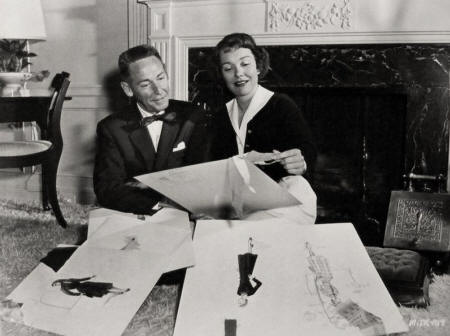Queer Places:
8401 Cresthill Rd, Los Angeles, CA 90069
 Milo
Leon Anderson (May 9, 1910 – November 3, 1984) was an American costume designer.
Howard Shoup was close friends with
Milo Anderson, whom he'd met at Warner Bros. And who would step up to
prominence after the departure of Orry-Kelly.
Anderson was just as overt and undisguised as Shoup. "Very gay," said
David Chierichetti, who knew
him well, "and absolutely unapologetic about it. In fact, I'd say, looking at
his designs, they were the farthest "out there" of any in the 1940s." Anderson
designed broadly and daringly, with frills and outlandish touches, but is
probably best remembered for the tight angora sweater he slipped onto Lana
Turner in They Won't Forget, the picture that skyrocketed her to stardom. Milo
knew what worked, what caught the eye, and from his youth had never been
afraid to say so.
Milo
Leon Anderson (May 9, 1910 – November 3, 1984) was an American costume designer.
Howard Shoup was close friends with
Milo Anderson, whom he'd met at Warner Bros. And who would step up to
prominence after the departure of Orry-Kelly.
Anderson was just as overt and undisguised as Shoup. "Very gay," said
David Chierichetti, who knew
him well, "and absolutely unapologetic about it. In fact, I'd say, looking at
his designs, they were the farthest "out there" of any in the 1940s." Anderson
designed broadly and daringly, with frills and outlandish touches, but is
probably best remembered for the tight angora sweater he slipped onto Lana
Turner in They Won't Forget, the picture that skyrocketed her to stardom. Milo
knew what worked, what caught the eye, and from his youth had never been
afraid to say so.
Born in Princeton, Illinois, he was the only boy in his Fairfax High School
class in fashion design. He already had a steady boyfriend by the age of
seventeen, a young man, as he would confide to Chierichetti, who was also
fancied by Adrian. Showing the veteran
designer his sketches, the teenaged Milo received little encouragement, but
was then surprised to discover Adrian had actually recommended him, apparently
as a joke, to Samuel Goldwyn. The joke was on Adrian: Anderson got the job on
The Greeks Had a Word for It (1932) and went on to become the boy wonder of
costume design, with a career lasting into the 1960s.
Milo Anderson attended the University of California. Briefly at United Artists in 1932, he became an important costumer at Warner Brothers (1933 to 1952), doing some of his best work on Technicolor films in the late 1930's. He later taught at the Sacramento Art Centre.
Milo Anderson made his film debut in 1932 and pursued his career primarily with Warner Bros. Thus, we owe him the costumes of many well-known films, such as The Adventures of Robin Hood by Michael Curtiz in 1938 (with
Errol Flynn and Olivia de Havilland), or Gentleman Jim by Raoul Walsh in 1942 (with Errol Flynn and Alexis Smith), two directors with whom he works regularly.
Other directors with whom he collaborated included Lloyd Bacon (e.g., Prologue in 1933, with James Cagney and Joan Blondell), William Dieterle (e.g., The Life of Louis Pasteur in 1935,with Paul Muni and
Josephine Hutchinson), Howard Hawks (e.g., The Port of Anguish in 1944, with Humphrey Bogart and Lauren Bacall), Alfred Hitchcock (a single film in 1950, The Great Alibi, with Jane Wyman and
Marlene Dietrich) and Mervyn LeRoy (e.g., Anthony Adverse in 1936, with Fredric March and Olivia de Havilland).
Milo Anderson contributed to a total of 200 American films (including several westerns)— often for women's costumes alone (mostly dresses) — the last in 1956, the year he retired.
My published books:


BACK TO HOME PAGE

 Milo
Leon Anderson (May 9, 1910 – November 3, 1984) was an American costume designer.
Howard Shoup was close friends with
Milo Anderson, whom he'd met at Warner Bros. And who would step up to
prominence after the departure of Orry-Kelly.
Anderson was just as overt and undisguised as Shoup. "Very gay," said
David Chierichetti, who knew
him well, "and absolutely unapologetic about it. In fact, I'd say, looking at
his designs, they were the farthest "out there" of any in the 1940s." Anderson
designed broadly and daringly, with frills and outlandish touches, but is
probably best remembered for the tight angora sweater he slipped onto Lana
Turner in They Won't Forget, the picture that skyrocketed her to stardom. Milo
knew what worked, what caught the eye, and from his youth had never been
afraid to say so.
Milo
Leon Anderson (May 9, 1910 – November 3, 1984) was an American costume designer.
Howard Shoup was close friends with
Milo Anderson, whom he'd met at Warner Bros. And who would step up to
prominence after the departure of Orry-Kelly.
Anderson was just as overt and undisguised as Shoup. "Very gay," said
David Chierichetti, who knew
him well, "and absolutely unapologetic about it. In fact, I'd say, looking at
his designs, they were the farthest "out there" of any in the 1940s." Anderson
designed broadly and daringly, with frills and outlandish touches, but is
probably best remembered for the tight angora sweater he slipped onto Lana
Turner in They Won't Forget, the picture that skyrocketed her to stardom. Milo
knew what worked, what caught the eye, and from his youth had never been
afraid to say so.

